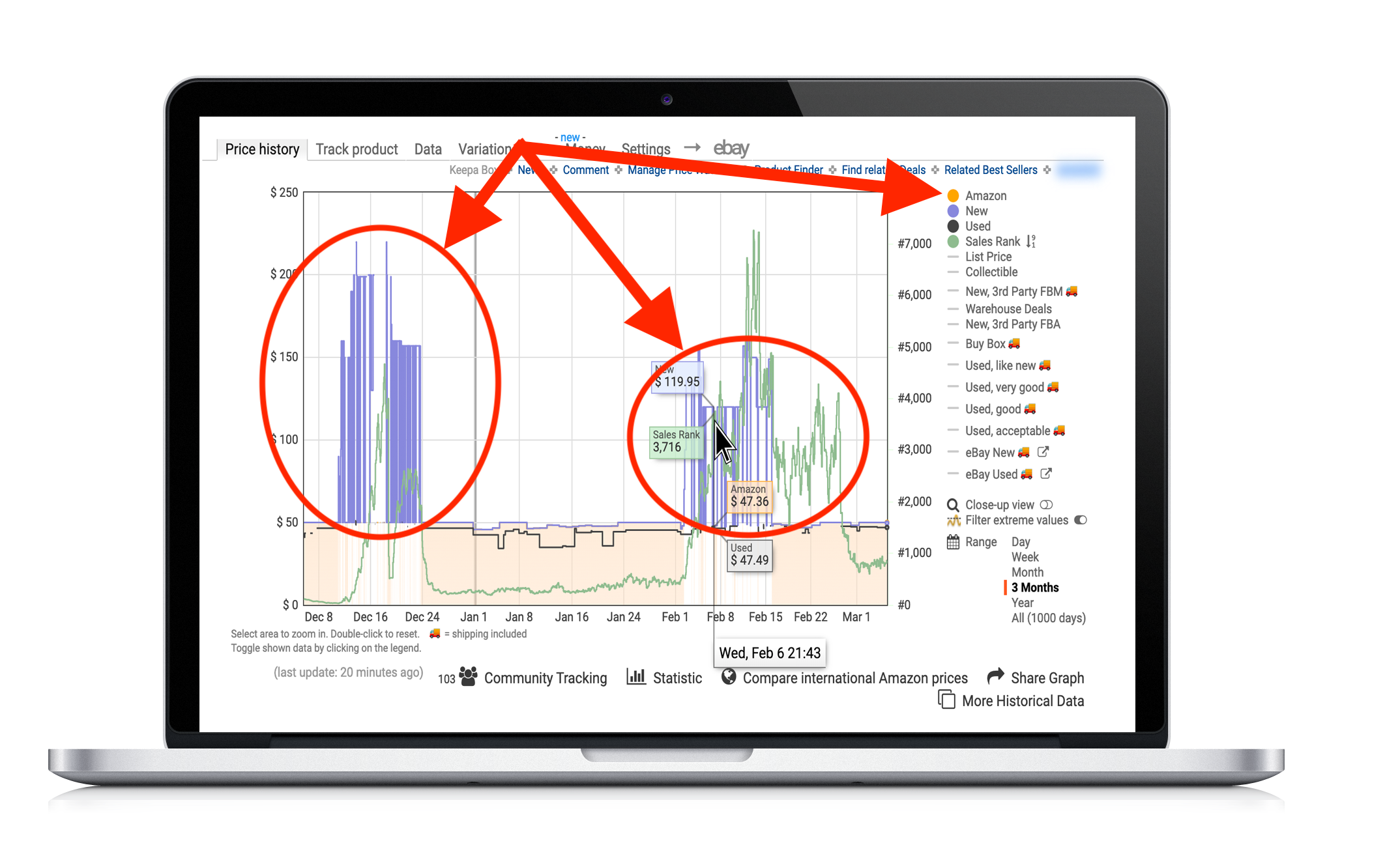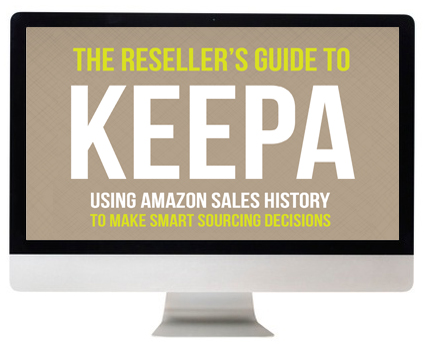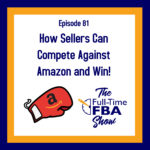Competing with Amazon as a third party seller can be a daunting task. It’s easy to feel that the odds are stacked against you. After all, it’s a huge company with tremendous resources and control over crucial elements, like who gets awarded the buy box. While it’s often wise to avoid competing with Amazon, it’s also important not to let fear blind you to potential opportunities of earning a customer’s sale.
In today’s episode, we outline the necessary conditions that make competing with Amazon a viable option. We discuss the many ways that Keepa graphs can be used to identify these instances ahead of time as well as minimize risk. We also take a look at various pricing strategies and how to employ them; the answers may surprise you! We conclude our episode by examining the best practices for minimizing risk and how to spot opportunities to help you obtain that coveted buy box. For all this and plenty of practical tips, join us today!
Listen on the podcast player below.
Like what you hear? Tell a friend… and be sure to leave us a rating and a review. Here’s how.
Key points from Episode 81:

- Why choosing the right time to compete with Amazon is crucial.
- Particular instances where Amazon is unlikely to share the buy box.
- When it’s useful to use a Keepa graph to determine when to compete with Amazon.
- Reasons why the buy box is so sought after.
- Tips for competing with Amazon on price, including lowering your costs significantly when you only have a few products left in stock.
- The benefits of staying informed when Amazon products are out of stock.
- How selling above retail can be employed as a pricing strategy.
- The best practices for minimizing risk when competing against Amazon.
- Making sure you don’t lose track of other third-party competitors.
- And so much more!
Links and resources mentioned in this episode:
 Keepa
Keepa- Free Intro to Keepa Training Video
- The Reseller’s Guide to Keepa video course
- How to Compete against Amazon and Win blog post
Right-click here and save as to download this episode to your computer.
 More Episodes from the Full-Time FBA Show podcast:
More Episodes from the Full-Time FBA Show podcast:
Don’t miss an upcoming episode! Subscribe, download episodes, and review the Full-Time FBA Show:
-
-
- Subscribe on iTunes
- Follow on Spotify
- Follow on Amazon Music (or just ask Alexa to “play The Full-Time FBA Show podcast”)
- Follow on iHeartRadio
- Subscribe on Podbean
- Subscribe on Podbay
- Subscribe on Podchaser
-
![]()
 The Reseller’s Guide to Keepa
The Reseller’s Guide to Keepa
I can’t imagine running my Amazon business without Keepa. It’s a tool (with both a free and a paid plan) that can dramatically improve your sourcing decisions. Keepa helps lower the risk of sourcing inventory items that end up tanking in price and increase your chances of selling inventory at the high prices you expect them to sell for.
I’m sure you know how it feels to buy an item expecting it to sell for a high price only to see the price tank soon after you send it to Amazon. With using Keepa the right way, you can protect yourself from that happening!
Basically, Keepa tracks the vital data on almost every item on Amazon. It can quickly show me the sales rank history, pricing history, buy box price history, used item history, Amazon in stock history, competitors’ stock levels, and so much more. With Keepa, I can easily look at the data from the past and better know what to expect in the future when it comes to price and sales velocity.
 To find out everything there is to know about using Keepa to make smart sourcing decisions, be sure to check out our course, The Reseller’s Guide to Keepa: Using Amazon Sales History to Make Smart Sourcing Decisions.
To find out everything there is to know about using Keepa to make smart sourcing decisions, be sure to check out our course, The Reseller’s Guide to Keepa: Using Amazon Sales History to Make Smart Sourcing Decisions.
With this course, you’ll make more confident sourcing decisions, better pricing decisions, and you’ll grow your Amazon business to the next level by selling your inventory faster and at higher prices!
Back to the main page for The Full-Time FBA Show
![]()
Episode 81 Transcript:
 [WELCOME]
[WELCOME]
[0:00:01.8] ANNOUNCER: Welcome to The Full-Time FBA Show. In each episode, it’s our goal to help you turn part time hours into a full-time income, selling almost anything on Amazon. Now, your hosts of the show, Stephen and Rebecca Smotherman.
[INTRODUCTION]
[0:00:21.2] STEPHEN: Welcome to episode number 81 of The Full-Time FBA Show. Today, we’re going to be talking about the strategy of how you can compete as a competitor with Amazon and win the sale. With me is my wife, Rebecca, I’m really glad you’re here today, Rebecca.
[0:00:36.1] REBECCA: Thanks. I am glad to be here too.
[0:00:38.0] STEPHEN: Yeah, we’re going to talk about something that a lot of people try to run away from, which is competing with Amazon and a lot of people fear it. We’re going to show you some times where you could overcome that and actually get the next sale.
[INTERVIEW]
[0:00:51.3] REBECCA: As Stephen said, we’re going to be talking about competing with Amazon today and what we mean by that is competing with Amazon as a seller on the Amazon platform. We’re third-party sellers and we’re talking about getting on a listing where Amazon is selling an item and competing against them and how to win the buy box, win the sales if you’re competing against them as a seller.
I would say that most, a lot of – I don’t know what the percentage would be of Amazon third-party sellers would say that competing against Amazon is a losing battle but you are saying that there’s a way to win, that you don’t mind competing against them. I would like to hear your reasons why because I think for the most part, I count myself among the number of people who don’t like to compete against Amazon for various reasons.
We’re genuinely going to be listening to what you have to say about this today, not me because I would be saying no, run away, don’t do it but you’re saying it’s okay.
[0:01:55.3] STEPHEN: Well, it’s okay in certain situations. The key to competing against Amazon and winning is to properly pick your battles, you want to make sure that you choose the right times to compete against Amazon. Most of the time, Amazon’s not going to share the buy box if they happen to be in stock the same time you are, they’re going to take the buy box, they’re going to try to lower their prices to get the next sale, they’re going to do what they can to put their inventory item in the buy box so they can get a sale.
A lot of times, that means third-party sellers are just kind of left out in the cold but if you know how to pick your battles, you can win those battles.
[0:02:29.7] REBECCA: Give us an example. What is a situation where you think that you can compete with Amazon and win?
[0:02:35.5] STEPHEN: I think a really good time where you can compete against Amazon and win is if you’re able to price significantly lower than Amazon’s price. There is a threshold, a line where Amazon will not lower their price to meet yours and will just kind of let you sell out. If you don’t have a high stock number of that particular item in stock, then Amazon might say, “Okay, you’ve got four or five in stock, I’ll let you sell out at this lower price” and of course, if you are able to still be profitable at that lower price, then that is a time where you can compete against Amazon and win.
You can even go and look at a Keepa graph and see for yourself, times in the past for that particular item where Amazon has shared the buy box. You can look at a Keepa graph, the pink line is the buy box line and you can just hover your cursor over the buy box line and it will tell you who had the buy box. Whether it was Amazon or a third-party seller and you can see what price that particular item was being sold for in the past and you can see, “Okay, Amazon’s priced it 29.99 but they’re sharing the buy box at 23.99, I’m still profitable at 23.99,” so I can be able to get the next sale as long as I’m not going too deep on a product.
[0:03:47.3] REBECCA: When you say that there are some categories where amazon just almost never shares the buy box with third-party sellers no matter how low the price, because that’s one of my issues.
[0:03:57.5] STEPHEN: Yeah, there are situations, I know from personal experience. Books, if you are trying to sell a book in new condition and Amazon is also selling a book in new condition, it is next to impossible to get Amazon to share the buy box at no matter how low your price is, they still want to get the sales. Have you noticed any other categories that might be a time where Amazon is not sharing the buy box?
[0:04:19.4] REBECCA: Yeah, I know for sure, for me, for shoes. It’s not 100% of the time but I tend to not like to buy shoes if Amazon is selling a particular variation because I found that even if you price significantly lower than Amazon, they just won’t give you the buy box and you could be listed as another option but you won’t get the buy box.
[0:04:41.9] STEPHEN: Yeah and in these conversations, we’ve talked a lot about the buy box. If you’re not aware of the buy box, that’s where over 80% of sales on Amazon come from, it’s the little box and the top corner of a product page on Amazon where it says “click here to buy” and you know, the lowest price does not always guarantee the buy box, especially when you’re competing against Amazon and so that’s the goal of every Amazon seller. Try to get your inventory in the buy box so that you can get most of the sales.
Very rarely do customers go look at other offers that are available and choose from other offers. Most people just choose from the buy box.
[0:05:16.2] REBECCA: Back to the question about sharing the buy box with Amazon. Have you noticed, does Amazon ever share the buy box if the seller is priced above Amazon?
[0:05:26.5] STEPHEN: That is a super rare unicorn but it does happen. It does happen sometimes and again, you can see this for yourself with a Keepa graph, you can go look at a product’s pricing history and you can look at Amazon’s price history and you can look at the buy box price history and you can see sometimes that buy box is priced higher than Amazon. Maybe Amazon is low on stock and they don’t want to go out of stock, who knows the reason why but every once in a while, and you can find out with a Keepa graph, just looking very quickly that Amazon does share the buy box even with a few sellers who are priced above them.
[0:06:01.4] REBECCA: Okay, that covers competing with Amazon on price. That’s the main factor, I think, that people are thinking about when they’re thinking about the buy box is are you priced lower, significantly lower or higher than Amazon when you’re trying to get that buy box but there’s other ways to compete with Amazon or any other seller for that matter to get the buy box. It’s not just price, what else should people be looking at?
[0:06:24.8] STEPHEN: Again, we go back to Keepa because Keepa gives us really, really valuable information. One of the things that Keepa can show you is that if you look in the recent history, you can see if Amazon has gone in and out of stock and how often. Maybe you’re sourcing an item and you see that Amazon as a competitor, well if you click it over to a Keepa graph it might show you that over the last three months Amazon has only been in stock about 50% of the time or 40%.
You can see for yourself the history and you can decide for yourself, “Do I want to compete against Amazon, wait for them to go out of stock and be able to get the next sale?” Again, don’t go too deep on something like this but it’s an opportunity where you can see, “Oh Amazon has a history of going in and out of stock and so I’ll just wait until they go out of stock” and the cool thing about when Amazon goes out of stock, a lot of times you can get the item sold for an even higher price than what Amazon is priced at.
Again, check out the Keepa graph, you can see for yourself. If you go to a Keepa graph and you have Amazon listed as an option for the data, you can see right there that on the graph, you can look at the dates and you can see Amazon is in stock when there is an orange shaded area and if there is a place where there is not an orange shaded area, that means Amazon is out of stock. You can get a little bit more information and see this kind of inaction.
If you go to fulltimefba.com/compete, that will actually show you the Keepa graph’s inaction for both of these situations when people are priced below the buy box or above the buy box, when people are priced below Amazon or above Amazon but still getting the buy box and also the times where Amazon goes in and out of stock. I can show you that on a little Keepa graph walkthrough video at fulltimefba.com/compete.
[0:08:05.2] REBECCA: The strategy you’re talking about there where people will price higher than Amazon waiting for Amazon to go out of stock is called above retail.
[0:08:13.2] STEPHEN: Yes.
[0:08:13.9] REBECCA: That’s one type of arbitrage strategy is to price your inventory above the retail price waiting for Amazon to go out of stock at the retail price and then when they’re out of stock, you can then sell your item above retail price. You can buy your inventory at retail price and still make a profit.
[0:08:33.2] STEPHEN: Yes.
[0:08:34.3] REBECCA: That’s just a little side note there.
[0:08:36.0] STEPHEN: Nice. Yes, I like that.
[0:08:37.5] REBECCA: About pricing on Amazon and strategies there. When it comes to competing with Amazon, are there any best practices to consider to help minimize your risk as I and many other sellers say, it’s not the best idea to make it a habit to compete against Amazon. It’s something you can consider in certain situations for sure but typically that’s not the preferred strategy but what would you do in those instances where you’re thinking about competing against Amazon. How would you minimize your risk?
[0:09:08.0] STEPHEN: Well, one of the things that I have said multiple times was “do not go too deep”. You don’t want to put too much money into inventory that you’re not 100% sure if Amazon is going out of stock or a 100% sure if you’re going to be able to get the buy box. These are kind of test runs; you can test things out. If you are successful, you can go back and get more if this is a replen opportunity but just don’t go too deep every time you send an inventory into Amazon where Amazon is a potential competitor.
The thing is to consider other competition. I mean you want to be curious about how many other competitors are selling that particular item, where they are priced at and how that plays into the role because you know, we don’t just compete against Amazon. We compete against all third-party sellers as well, so we want to get the buy box. We want to make sure that we are priced competitively but take that into consideration as well.
Once again, competing with Amazon is not something that we tell people to do for every product but if you pick your battles, you are able to win the next sale if you’re able to make some really smart choices. That’s what this whole podcast episode was all about and hopefully now, you are equipped to know the right times and the wrong times to compete with Amazon to get the next sale.
[CLOSING CONVERSATION]
[0:10:20.9] REBECCA: All right, well, thanks for joining us this week for this episode of The Full-Time FBA Show. As always, you can find any of the links that we’ve been talking about or the transcript of this episode at the link fulltimefba.com/81, the number 81 because this is episode 81.
[0:10:38.8] STEPHEN: Next week on the show, we are going to be sharing our six things we wish we did earlier in our Amazon FBA business. You don’t want to miss out on that and be sure you are subscribed or you follow The Full-Time FBA Show, so that you make sure you don’t miss out on any of our upcoming episodes. That’s it for today, thanks so much for joining us and we’ll see you next week.
[OUTRO]
[0:11:00.2] ANNOUNCER: That is all for this episode of The Full-Time FBA Show. So head over to fulltimefba.com/podcast, where you will find the show notes and links from this episode. While you’re there, subscribe to our newsletter where you’ll get several free downloads of our popular and helpful Amazon FBA resources. Now, take action on what you have learned today so you can find success at turning part-time hours into a full-time income with Amazon FBA.
[END]

Leave a Reply